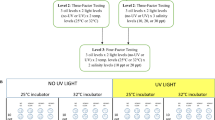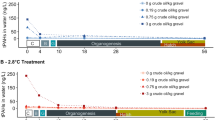Abstract
The combined effect of salinity, temperature and chronic exposure to water-soluble fractions (WSF) of a No. 2 fuel oil on the survival and development rate of embryos ofFundulus heteroclitus Walbaum are described. The embryos were exposed at 3 salinities (10, 20, 30‰ S) and 3 temperatures (20°, 25°, 30°C) to 3 different oil concentrations (15, 20, 25% WSF, equivalent to approx 0.28, 0.38 and 0.47 ppm total naphthalenes) and to one control without oil. The results were analyzed by responsesurface methodology. The lowest oil concentration was only mildly toxic to embryos under optimal salinity/temperature conditions, while the highest was extremely toxic in all factor combinations. Under optimal conditions, only the highest oil concentration resulted in more than 50% mortality. Under suboptimal conditions, especially high and low temperatures, all 3 oil concentrations caused greater than 50% mortality. The interactive effect of salinity and temperature on survival was greatest at the lowest oil concentration. Temperature had a marked effect and salinity only a slight effect on the developmental rate of the embryos. Exposure to the low oil concentration tended to increase the temperature sensitivity of developmental duration slightly. Generally, exposure to oil decreased the time interval between fertilization and hatching.
Similar content being viewed by others
Literature Cited
Alderdice, D.F.: Responses of marine poikilotherms to environmental factors acting in concert.In: Marine ecology, vol. Part 3. pp 1659–1722. Ed. by O. Kinne. London: Wiley-Interscience 1972
Anderson, J.W., D.B. Dixit, G.S. Ward and R.S. Foster: Effects of petroleum hydrocarbons on the rate of heart beat and hatching success of estuarine fish embryos.In: Physiological responses of marine biota to pollutants, pp 241–258. Ed. by F.J. Vernberg, A. Calabrese, F.P. Thurberg and W.B. Vernberg. New York: Academic Press 1977
—, J.M. Neff, B.A. Cox, H.E. Tatem and G.M. Hightower: The effects of oil on estuarine animals: toxicity uptake and depuration, respiration.In: Pollution and the physiology of marine organisms, pp 285–310. Ed. by F.J. Vernberg and W.B. Vernberg. New York: Academic Press 1974a
—————, J.M. Neff, B.A. Cox, H.E. Tatem and G.M. Hightower: Characteristics of dispersions and watersoluble extracts of crude and refined oils and their toxicity to estuarine crustaceans and fish. Mar. Biol.27, 75–88 (1974b)
Armstrong, H.W., K.W. Fucik, J.W. Anderson and J.M. Neff: Effects of oilfield brine effluent on benthic organisms in Trinity Bay, Texas, 81 pp. Washington D.C.: American Petroleum Institute 1977. (Publs Am. Petrol. Inst. No. 4291)
Balon, E.K.: Terminology of intervals in fish development. J. Fish. Res. Bd Can.32, 1663–1670 (1975)
Barr, A.J., J.H. Goodnight, J.P. Sall and J.T. Helwig: A users guide to SAS 76, 329 pp. Raleigh, North Carolina: SAS Institute, Inc. 1976
Blaxter, J.H.S.: Development: eggs and larvae.In: Fish physiology, Vol. III. pp 177–252. Ed. by W.S. Hoar and D.J. Randall. New York & London: Academic Press 1969
Boyd, J.F. and R.C. Simmonds: Continuous laboratory production of fertileFundulus heteroclitus (Walbaum) eggs lacking chorionic fibrils. J. Fish. Biol.6, 389–394 (1974)
Boylan, D.B. and B.W. Tripp: Determination of hydrocarbons in seawater extracts of crude oil and crude oil fractions. Nature, Lond.230, 44–47 (1971)
Clark, Jr., R.C. and W.D. MacLeod, Jr.: Inputs, transport mechanisms, and observed concentrations of petroleum in the marine enviroment.In: Effect of petroleum on arctic and subarctic marine environments and organisms, Vol. 1. pp 91–223. Ed. by D.C. Malins. New York: Academic Press 1977
Dunn, B.P. and H.F. Stich: The use of mussels in estimating benzo (a) pyrene contamination of the marine environment. Proc. Soc. exp. Biol. Med.150, 49–51 (1975)
Ernst, V.V., J.M. Neff and J.W. Anderson: The effects of the water-soluble fractions of No. 2 fuel oil on the early development of the estuarine fish,Fundulus grandis Baird and Girard. Envir. Pollut.14, 25–35 (1977)
Gilmore, Jr., R.G.: Fishes of the Indian River Lagoon and adjacent waters, Florida. Bull. Fla St. Mus. biol. Sci.22, 101–148 (1977)
Griffith, R.W.: Environment and salinity tolerance in the genusFundulus. copeia2, 319–331 (1974)
Grossling, B.F.: An estimate of the amounts of oil entering the oceans.In: Sources, effects and sinks of hydrocarbons in the aquatic environment, pp 5–36. Washington, D.C.: American Institute of Biological Sciences 1976
Holliday, F.G.T. and J.H.S. Blaxter: The effects of salinity on the developing eggs and larvae of the herring. J. mar. biol. Ass. U.K.39, 591–603 (1960)
Joseph, E.B. and V.P. Saksena: Determination of salinity tolerance in mummichog (F. heteroclitus) obtained from hormone-induced spawning. Chesapeake Sci.1, 193–197 (1966)
Cinne, O.: The effects of temperature and salinity on marine and brackish water animals. I. Temperature. Oceanogr. mar. Biol. A. Rev.1, 301–340 (1963)
—: The effects of temperature and salinity on marine and brackish water animals. II. Salinity and temperature salinity combinations. Oceanogr. mar. Biol. A. Rev.2, 281–339 (1964)
Laughlin, Jr., R., O. Lindén and J.M. Neff: Loss of naphthalenes from water as a function of salinity and temperature. (In preparation)
Lindén, O., R. Laughlin, Jr., J.R. Sharp and J. M. Neff: The combined effect of salinity, temperature and chronic low level oil concentration on the growth pattern of embryos of the killifish,Fundulus heteroclitus Walbaum. (In preparation)
McKim, J.M.: Evaluation of tests with early life stage of fish for predicting long term toxicity. J. Fish. Res. Bd Can.34, 1148–1154 (1977)
National Academy of Sciences: Petroleum in the marine environment, 107 pp. Washington D.C.: National Academy of Sciences 1975
Neff, J.M. and J.W. Anderson: An ultraviolet spectrophotometric method for the determination of naphthalene and alkylnaphthalenes in the tissues of oil-contaminated animals. Bull. envir. Contam. Toxicol.14, 122–128 (1975)
—— and J.W. Anderson, B.A. Cox, R. Laughlin, Jr., S.S. Rossi and H.E. Tatem: Effects of petroleum on survival, respiration and growth of marine animals.In: Sources, effects and sinks of hydrocarbons in the aquatic environment, pp 515–539. Washington D.C.: American Institute of Biological Sciences 1976
Rosenthal, H. and D.F. Alderdice: Sublethal effects of environmental stressors, natural and pollutional, on marine eggs and larvae. J. Fish. Res. Bd Can.33, 2047–2065 (1976)
Rossi, S.S. and J.M. Neff: Toxicity of polynuclear aromatic hydrocarbons to the marine polychaete,Neanthes arenacreodentata. Mar. Pollut. Bull.9, 220–223 (1978)
Scarratt, D.J. and V. Zitko: Bunker C oil in sediments and benthic animals from shallow depths in Chedabucto Bay, N.S., J. Fish. Res. Bd Can.29, 1347–1350 (1972)
Sharp, J.R., K.W. Fucik and J.M. Neff: Physiogical basis of differential sensitivity of fish embryonic stages to oil pollution.In: Marine pollution: functional processes, Ed. by F.J. Vernberg, W.B. Vernberg and A. Calabrese. New York: Academic Press. (In press). (1978)
Trinkaus, J.P.:Fundulus.In: Methods in developmental biology, pp 113–122. Ed. by F.H. Wilt and N.K. Wessels. New York: T.Y. Gowell Co. 1967
Wilson, K.W.: The laboratory estimation of the biological effects of organic pollutants. Proc. R. Soc. (Ser. B)189, 459–477 (1975)
Youngblood, W.W. and M. Blumer: Polycyclic aromatic hydrocarbons in the environment: homologous series in soils and recent marine sediments. Geochim. cosmochim. Acta39, 1303–1314 (1975)
Author information
Authors and Affiliations
Rights and permissions
About this article
Cite this article
Lindén, O., Sharp, J.R., Laughlin, R. et al. Interactive effects of salinity, temperature and chronic exposure to oil on the survival and developmental rate of embryos of the estuarine killifishFundulus heteroclitus . Marine Biology 51, 101–109 (1979). https://doi.org/10.1007/BF00555189
Accepted:
Issue Date:
DOI: https://doi.org/10.1007/BF00555189




